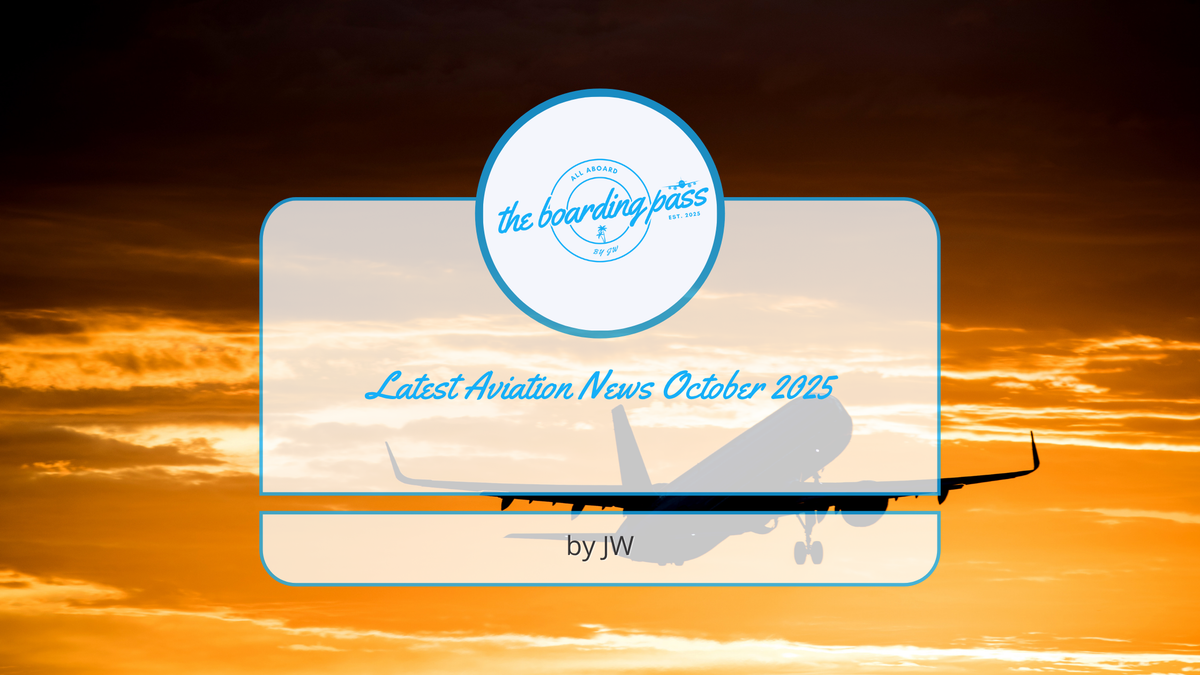Aviation Industry News Round-Up: October 2025
Welcome back to The Boarding Pass Travel Blog. If the skies could talk, October 2025 would sound like a mix of static, turbulence, and the faint ping of a seatbelt sign. From route cancellations to farewell callsigns, and from sustainability pledges to billion-dollar supply chain headaches, the aviation industry has been anything but dull. Buckle up, pull down your blind, here’s your Boarding Pass to the latest headlines cruising at 35,000 feet.
U.S. Revokes 13 Routes from Mexican Airlines
Let’s start with a bit of international turbulence. The U.S. Department of Transportation has pulled approval for 13 routes operated by Mexican airlines, citing competition and compliance concerns. It’s a move that’s left travellers, and indeed the airlines, grounded in confusion.
Officials insist the decision is about levelling the playing field, but for many frequent flyers, it’s yet another reminder that aviation diplomacy is often as complex as air traffic control at rush hour. Expect to see lobbying, negotiations, and a few sharp press releases before this one smooths out.
Farewell to the “HAWAIIAN” Callsign
Endings in aviation always hit a little harder. Hawaiian Airlines has officially retired its iconic “HAWAIIAN” callsign, marking the end of a 95-year-old brand as it merges into Alaska Airlines’ operations. The final flight using the old callsign landed in Honolulu on 29 October 2025. It's a poignant moment for pilots, cabin crew, and islanders who grew up hearing “HAWAIIAN xxx heavy” echo across the Pacific.
Aviation is full of symbols, tailfins, uniforms, callsigns. Losing one feels like saying goodbye to an old friend. Still, the spirit of aloha will live on, albeit under a different name and flight code.
Aviation Taxes Have Limited Impact on Travellers
A new study from Transport & Environment (T&E) has shaken up the debate around flight taxes. The research found that aviation levies and charges have surprisingly little effect on passenger numbers.
In other words, travellers may grumble about fees, but few are leaving their boarding passes behind. The real drivers of demand are airline pricing strategies, destination trends, and good old-fashioned wanderlust. For policymakers, that means focusing on innovation and cleaner fuels might yield more results than tweaking tax codes.
So, while your next fare might still come with an alphabet soup of surcharges, it’s unlikely to ground your holiday plans.
Winter 2025 Trends: Routes, Fares and On-Time Data
According to OAG’s October aviation data, the global network is gearing up for one of the busiest winter seasons since 2019. Low-cost carriers continue to dominate short-haul routes, while long-haul operations are slowly catching up, led by transatlantic and Middle Eastern hubs.
Fares are stabilising after a few months of unpredictable spikes, and airports like Doha, Amsterdam, and Singapore are posting impressive on-time performance figures. The takeaway? Travel fatigue is fading fast. People are flying again for fun, for business, and sometimes just for the sheer pleasure of hearing the safety demonstration in three languages.
Supply Chain Delays Could Cost Airlines $11 Billion
While passengers may not notice it yet, the aviation supply chain is under immense strain. A joint study by IATA and consultancy Oliver Wyman estimates that delayed production, parts shortages, and maintenance bottlenecks could cost airlines more than $11 billion this year.
From engine components to seating frames, manufacturers are playing catch-up after years of pandemic disruption. The result? Longer lead times, grounded aircraft awaiting spares, and a few frustrated fleet managers pacing hangars with clipboards.
The silver lining is that this pressure is driving fresh investment in local manufacturing and digital tracking systems, another reminder that every crisis in aviation seems to inspire a new kind of innovation.
ICAO and Industry Leaders Focus on Net-Zero Goals
The International Civil Aviation Organization (ICAO) hosted its latest assembly this month, and the talk of the tarmac was sustainability. Airlines, regulators, and manufacturers are grappling with how to achieve the industry’s net-zero by 2050 goal while keeping tickets affordable and operations profitable. Can affordable and profitable work in the same sentence?
Sustainable Aviation Fuel (SAF) remains the star of the show, though the challenge is scaling production without turning farmland into fuel farms. Some carriers are experimenting with hydrogen and electric hybrids, while others are investing in carbon-capture partnerships.
It’s an ambitious journey, but one thing’s clear, the conversation has shifted from “if” to “how fast”.
What This All Means for Travellers
So, what should we make of it all? On one hand, it’s business as usual — mergers, regulations, and supply hiccups. On the other, aviation is quietly reinventing itself. The blend of nostalgia (goodbye Hawaiian), necessity (fix the parts pipeline), and innovation (fly cleaner, faster, smarter) paints a fascinating picture of an industry that never truly sits still.
If you love the smell of jet fuel in the morning, or just miss the thrill of boarding a plane bound for somewhere warmer, this is an exciting time to watch the skies.

